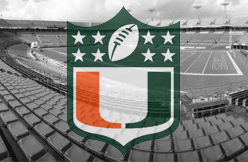Years ago, Miami Hurricanes running back Duke Johnson would have been categorized as a scatback once he made the transition to the NFL. In today's game, Johnson would fall under the more common designation of a third-down back. What Johnson won't be is projected as a feature back who can carry the load for an NFL offense.
But that doesn't mean his value is completely diminished.
In a class that features an elite, albeit injured, talent in Georgia's Todd Gurley, a potential first-round pick in Wisconsin's Melvin Gordon and a wild card in Boise State's Jay Ajayi, Johnson holds advantages over all three of them.
Johnson is healthier at the moment than Gurley. The Miami product is far more polished in the passing game compared to Gordon. And Johnson's overall speed and quickness are superior to Ajayi's.
This combination will help place Johnson among the top five running backs in this year's class. The problems, though, stem from concerns over Johnson's size and durability.
The Miami native is listed at 5'9" and 206 pounds.
Weight certainly fluctuates for all athletes, and some of those listed measurements most likely haven't been updated in years. But the general consensus is that only one of the league's top rushers claims a smaller frame than Johnson.
Johnson's durability also remains in question due to his size.
The running back fractured his right ankle in a 2013 contest against the Florida State Seminoles. The same ankle was injured during the Hurricanes' 24-21 loss to the South Carolina Gamecocks in the 2014 Independence Bowl. However, Johnson told The State's Josh Kendall it wasn't a severe injury.
A running back's durability extends beyond his ability to stay on the field, though.
A player takes a beating at the position throughout his career. A running back's shelf life isn't expected to be more than a handful of years, or whenever that player is about to reach 30 years old.
While fewer carries at the collegiate level can be seen as a positive for running back prospects, it also leaves room to question the back's ability to thrive as a team's No. 1 option out of the backfield.
Comparisons to the Philadelphia Eagles' LeSean McCoy and the Kansas City Chiefs' Jamaal Charles will be cited to place Johnson in a favorable light due to their similar statures.
McCoy, though, showed during his time with the Pitt Panthers that he could be the team's primary runner and carry a heavy load. In his two seasons compared to Johnson's three in Miami, McCoy actually accumulated more carries.
Charles' career path at Texas was much closer to Johnson's, but the current Chief still isn't the ideal comparison. The Cincinnati Bengals' Giovani Bernard's career path, which started with the North Carolina Tar Heels, may be the best example for how Johnson will transition to the NFL level.
During his first season with the Chiefs, Charles learned behind Larry Johnson. Bernard, meanwhile, only carried the ball 10.6 times per game as a rookie after being drafted in the second round of the 2013 draft.
This type of scenario would be ideal for Duke Johnson.
But even if the Miami running back is eventually placed into a similar situation, it doesn't guarantee success.
After exploding onto the scene as a rookie, Bernard was viewed as the new No. 1 running back in Cincinnati. Bernard's increased role didn't last long.
Through the initial five games of the 2014 season, Bernard averaged 17.2 carries. He then injured his ribs against the Indianapolis Colts on Oct. 19. The running back also suffered an injured shoulder and knee as the season progressed. By the end of the campaign, Bernard missed three games and averaged only 10.2 carries over his final eight games.
The Bengals instead turned to Jeremy Hill, a 238-pound rookie. Not only did the LSU product assume the lead back duties, but he went on to be one of the NFL's most productive running backs.
This is the concern that surrounds Duke Johnson. Can he hold up to the rigors of the NFL, or is he merely a rotational player among a team's running back stable?
Like Bernard, Duke Johnson's value truly lies in his versatility.
During his final season on campus, Bernard averaged 6.7 yards per carry compared to Johnson's 6.8. The North Carolina standout snagged 47 receptions, while Duke Johnson grabbed 38. Both also proved to be dynamic returners during their careers.
As a pure runner, the Miami running back owns elite straight-line speed, tremendous lateral quickness and the ability to make a cut without slowing down.
After running for 1,652 yards as a junior, Duke Johnson declared early for the draft. During his final collegiate campaign, he became Miami's all-time leading rusher.
Think about that for a second.
During his time in Coral Gables, Duke Johnson was more productive than Ottis Anderson, Edgerrin James, Clinton Portis, Willis McGahee and Frank Gore.
However, Duke Johnson isn't the most physical runner. His speed makes him a valuable commodity, but he shouldn't be expected to break tackles or excel as a short-yardage runner at the next level.
The running back starts to separate himself as a receiver out of the backfield. Duke Johnson caught 38 passes for 421 yards as a junior. He isn't simply a check-down option either; the running back ran wheel and seam routes during the season. He can be a downfield threat when placed in the right situations.
Current players such as Reggie Bush and Darren Sproles bring the same value to their teams. Neither is counted upon to carry the ball more than 10-12 times per game, but each serves as one of his respective team's best receivers.
The running back is also a willing blocker. While Duke Johnson can be overwhelmed at the point of attack, he does a good job recognizing pressure and picking up the right blitzer or free rusher.
Duke Johnson even brings added value as a dynamic kick returner. While he wouldn't be the team's top option out of the backfield, the upcoming rookie can prove to be a major presence on special teams.
Prior to his junior season in which Miami coach Al Golden decided to use him only as a running back, Johnson averaged 31.4 yards per kick return. He also recorded a pair of touchdowns as a true freshman.
The Arizona Cardinals, Minnesota Vikings, Oakland Raiders and San Diego Chargers are organizations that require running back depth and also finished 22nd overall or worse in kick return average.
As the NFL becomes more and more specialized with each passing season, the ability to contribute in multiple areas makes prospects like Johnson valuable commodities.
The Miami product's speed with the ball in his hands, ability to contribute in a team's passing attack and brilliance in the return game as a special teams ace will make Duke Johnson a early-round pick in April's NFL draft.
Just don't ask him to be a workhorse in a run-heavy offense.

(bleacherreport.com)



